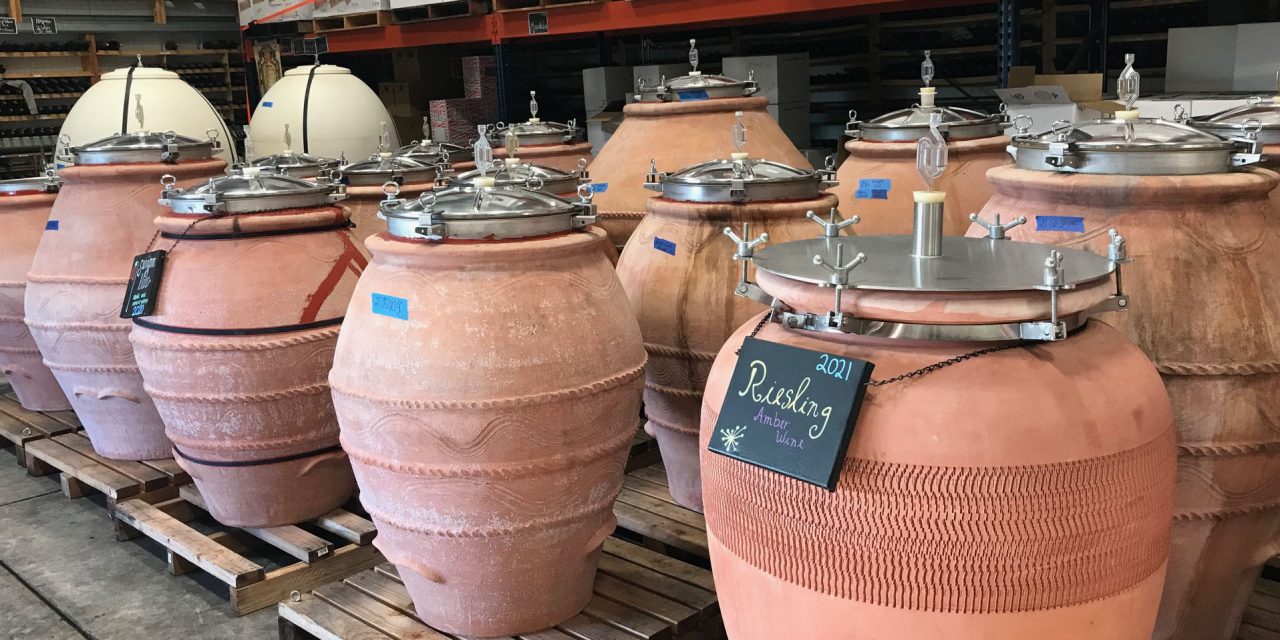
Paso Robles’ nonconforming winemakers are so ahead of the curve they have circled back some five millennia to an ancient vinification and storage system in the theory that everything old is new again.
“It’s bringing back Old World into modern winemaking, it’s fun to use such a historical vessel,” confessed Valia From, owner/winemaker of Desperada Wines who embarked on amphora vinification in 2012 for production of whites such as sauvignon blanc and chenin blanc, and nebbiolo and barbera among the reds.
In recent years local winemakers have embraced winemaking in amphorae producing textural and nuanced wines. These egg-shaped clay vessels tapering to a flat bottom were historically used in Georgia, its birthplace, and then spread globally from China to the Mediterranean area.

Photos: Mira Honeycutt
So, I guess it’s no coincidence that the Paso Robles History Museum downtown is staging an informative exhibit, “6,000 Years of Winemaking in Clay Amphorae,” curated by the San Luis Obispo-based Wine History Project. The comprehensive exhibit includes framed maps, historic timelines, a selection of clay vessels and an Amphora Wine Trail map that lists 12 Paso wineries and one in Edna Valley that swear by amphora-vinification. The exhibit runs through February 28, 2022.
In 2011 Paso’s Ambyth Estate, a winery focused on Rhône-style wines, was the first winery to import amphorae from Italy. What started with a couple of amphorae has morphed into 20-some vessels mostly from Italy and a few from Australia and California, ranging in size from 350 liters to 750 liters. The winery lined up with the assorted vessels, is reminiscent of a museum of Chinese Terracotta Warrior sculptures. Founded in 2003 by Phillip and Mary Hart, Ambyth is also Paso’s first Demeter-certified biodynamic vineyard.
The amphora’s renaissance began in Italy’s northeastern region of Friuli, mostly by a group of winemakers drawn to organic and biodynamic farming and natural winemaking practices.
These non-intervention style winemakers saw many benefits to amphora-vinification: the superior insulation gives wines its freshness; clay reacts enzymatically with wine and raises its pH to pull out acidity; and, most of all, the porous vessel allows oxygen into wine twice as fast as wood barrels.
Gelert Hart, Phillip’s son and currently Ambyth’s winemaker, calls it happy oxidation. “It’s the most neutral aging vessel that still allows the wine to breathe age into a classic old-world style,” Gelert explained in an email from Costa Rica. He uses both amphorae and barrels for fermentation and aging red, white, Rosé, orange wines and cider. And, yes, there is a difference.
There’s no shock when the final product bottle is opened, even with no additives like sulfites. Furthermore, amphorae smooth acids and don’t manipulate flavors in the wine as much as oak barrels do, he noted. “This way we find you can taste more of the terroir rather than the aging vessel.”
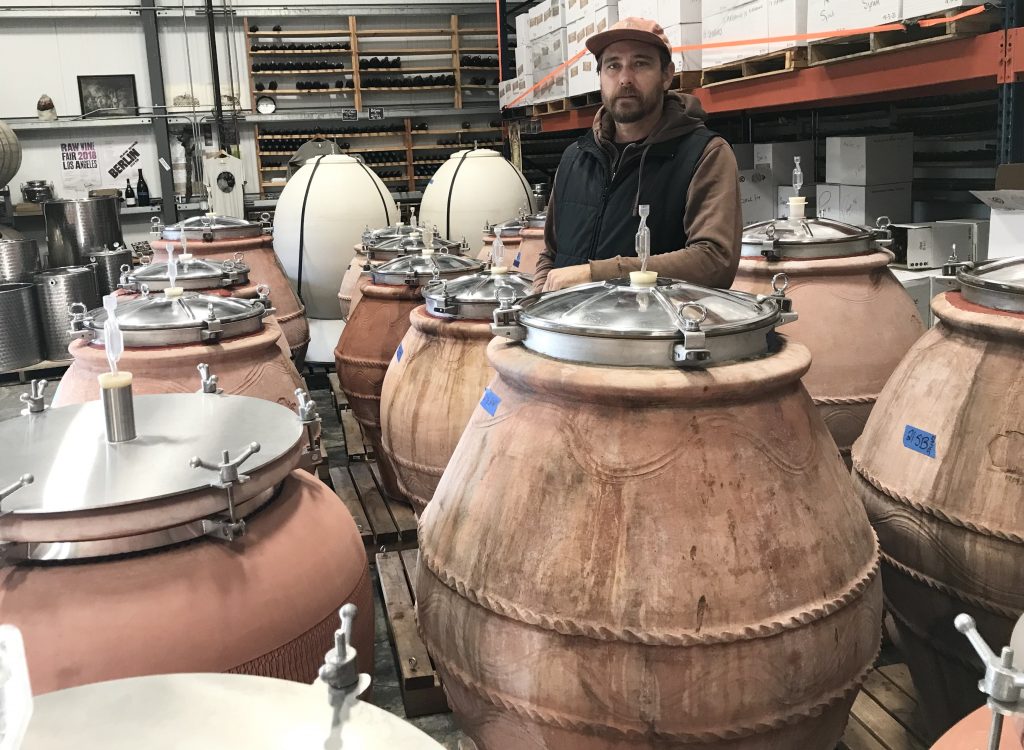
“Paso is one of the early adopters,” commented winemaker Anthony Yount, who uses amphorae for some of the production at Denner Vineyards, Sixmilebridge and his own Kinero label.
Indeed, it was Ambyth’s introduction of amphorae that sparked interest among locals. Winemakers such as Giornata Wine’s co-founder and winemaker Brian Terrizzi got his first amphorae from Ambyth’s second Italian shipment in 2012.
The amphora phenomenon was a natural fit for Terrizzi, who leans toward natural winemaking and focuses on Italian wines. He began using amphorae for some of his white Italian varieties. “It’s part of the natural movement and we don’t add yeast or nutrients,” Terrizzi asserted. “Barrels give wine a lot of flavor and amphorae don’t, and the shape helps ferment wines faster.”
On a brisk December afternoon, we settled at a patio table on Giornata’s terrace in Tin City. Terrizzi’s whites are anything but — they are tinted in pastel colors of orange and pink. These “Orange Wines” (made by leaving skins of white wine grapes to ferment with the juice) are all the rage among millennials and popular with winemakers using amphorae.
We sampled 2020 vintages of the orange-hued Falanghina, expressing a fresh cidery flavor; a citrusy Fiano; a peachy Friuliano; and a surprising Rosé of pinot grigio.
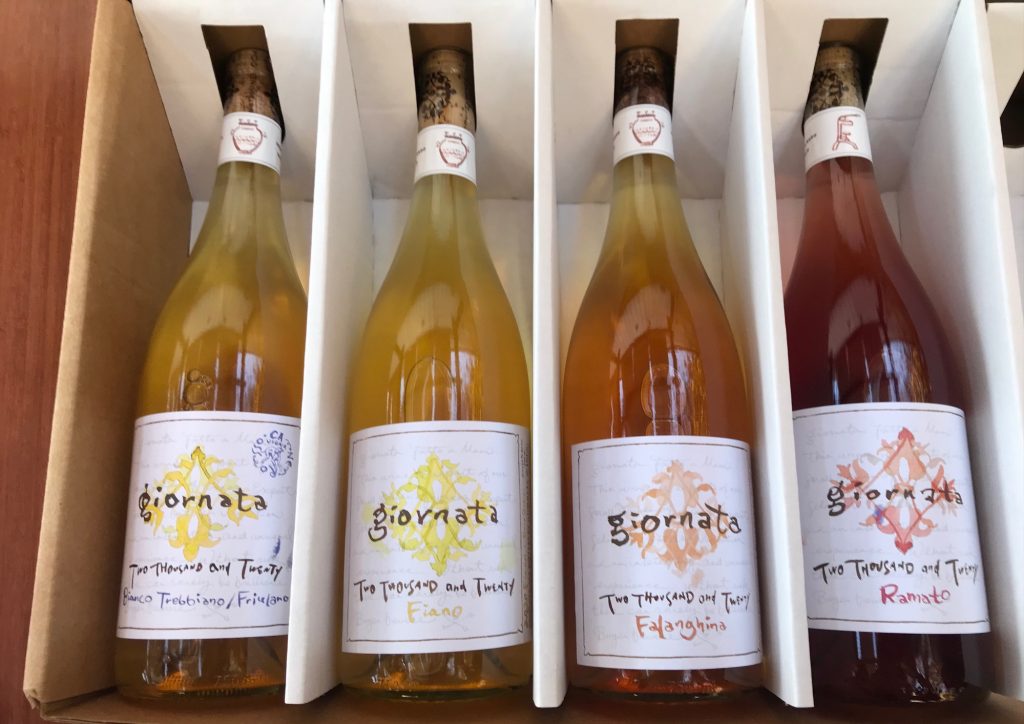
Across the street in Tin City, Dave McGee, owner of Monochrome, known as a white-wine-only house, also uses multiple vessels for fermentation and aging. We tasted the Analog in a Digital Age 2018, a marsanne blended with a splash of grenache blanc and viognier, a wine expressing aromatic flavors and a textural mouthfeel. McGee’s style is to blend amphora-aged wines with whites made in other vessels to give a range of flavors. “It lends more complexity,” he said.
Sherman Thacher of his namesake winery is another true believer in non-intervention. “We practice super low intervention; we bring in the grapes and they follow their own path,” said the winemaker who tends to favor neutral oak and therefore likes the neutrality of amphora. “The wines retain a freshness.” For chenin blanc and cinsault bottlings, Thacher will use multiple vessels like amphora and neutral oak barrels for vinification.
I savored another white wine at Derby Wine Estate, a 2019 roussanne, fermented and aged in amphora for six months then finished aging in stainless steel for three months. “Roussanne is a challenging grape for growers and winemakers — it’s mysterious,” said winemaker Sean Geoghegan. “That’s why I chose amphora. It tends to make textural wines.”

“The terra cotta material imparts no flavor whereas wood barrels depending on the application could impart flavor,” noted Janis Pelletiere Denner, owner of Pelletiere Vineyard & Winery, who acquired her two 500-liter amphorae in 2015 for her sangiovese program.
While the 500-liter size is most popular, at Denner I came across two extremely large 7.5 hectoliter vessels which Yount uses for Sixmilebridge and Kinero, wines that are produced at Denner winery. Known as cocciopesto, the large vessels are made from a combination of clay, cement and sandstone with five-inch-thick walls as opposed to one-inch thickness in smaller vessels. “Cocciopesto allows longer fermentation and more tannins,” explained Yount.
From Denner, I savored two iterations of Dirt Worshipper, a syrah with a splash of roussane. The 2013 vintage was fermented in stainless steel and aged in oak barrels for five months. Then the wine was split — half into amphora and the other half remained in oak. Both versions aged another 17 months. The inky dark wines stood apart: the amphora-aged showing herbal notes with hints of olive tapenade while the voluptuous oak version came off lush with fruit and expressive tannins.
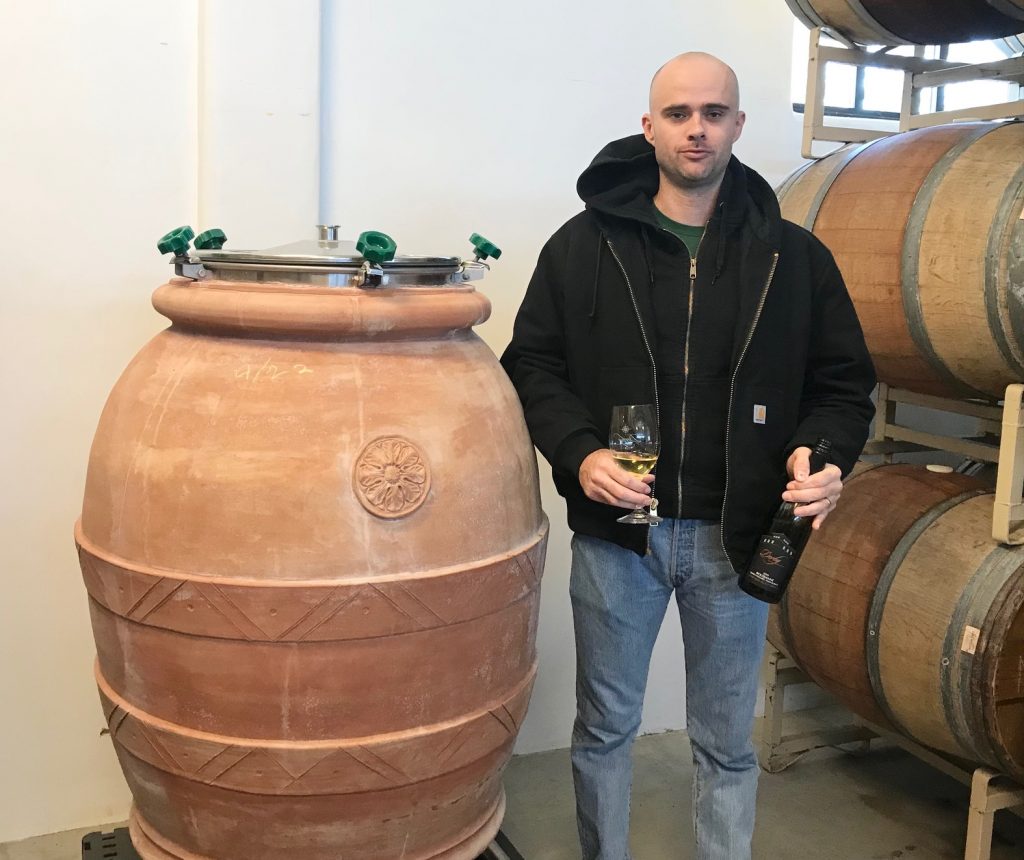
Epoch’s Jordan Fiorentini admitted she’s still in the experimental stage with the one amphora she acquired for Epoch Estate in 2013. “Amphora can be more oxidative and my style is reductive winemaking,” she noted. She has tried making mourvèdre, aged 12 months in amphora and eight in oak barrels, and loves the earthy characters of the wine. Still, this is an experiment: “Have to do more trials. I would like to put a more tannic syrah for my style,” she confessed.
So how do these local winemakers access their amphorae?
Enter Manu Fiorentini, Jordan’s Italian-born husband and founder of Itek Wine launched in Paso in 2010. Fiorentini was already importing oak barrels, concrete wine tanks and other stainless-steel equipment. By 2012, he added amphorae to his business.
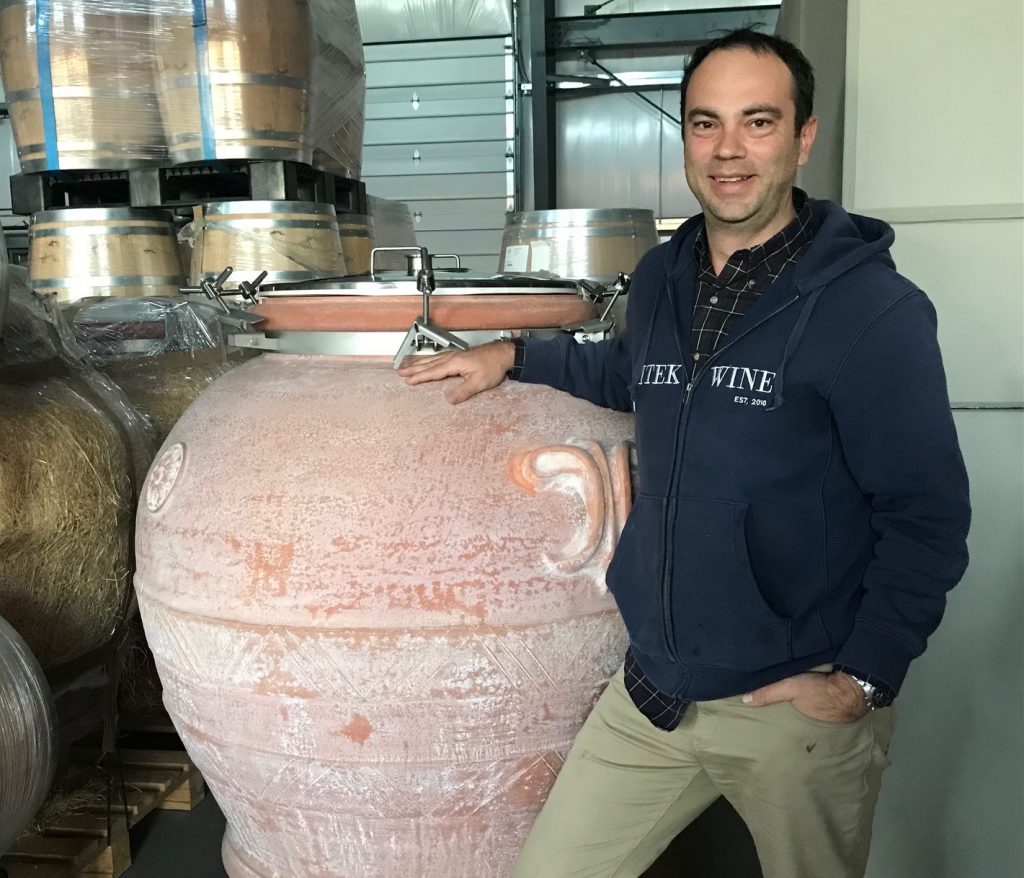
“I ordered a container load,” said Fiorentini. By the time the shipment arrived from Italy, he had already sold 40 amphorae. His winery customers are located all over North America, but his largest clientele is here in Paso. “People here are more experimental with these vessels,” Fiorentini remarked. Plus, being local helps in terms of servicing the vessels.
To savor amphora-made wines visit some of the above plus other Paso wineries such as Clesi, Indigené, Lone Madrone, Thibido and Chamisal in Edna Valley.

